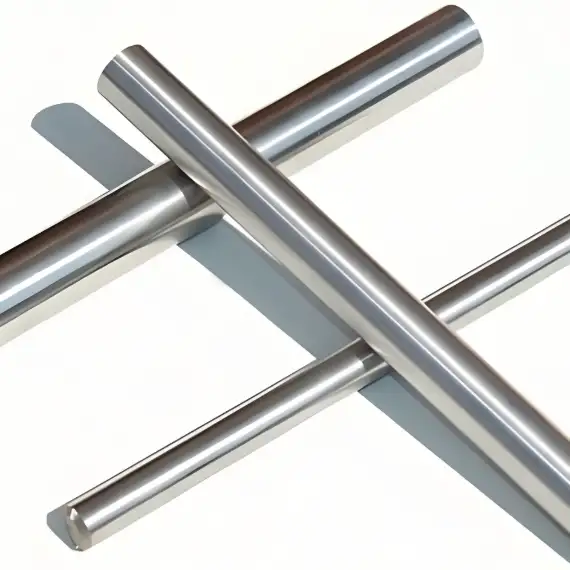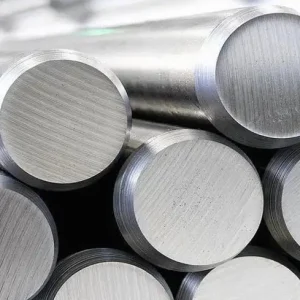PH13-8Mo is a premium, martensitic precipitation-hardening stainless steel that delivers very high strength, excellent toughness, and improved resistance to stress-corrosion cracking relative to many PH grades. For high-duty aerospace, oil & gas, and high-performance industrial parts, PH13-8Mo provides a unique mix of mechanical performance and corrosion resistance. MWAlloys supplies PH13-8Mo round and forged bars from China at 100% factory pricing with stocked sizes for rapid shipment.
What is ph13 8 material?
PH13-8Mo (often written PH 13-8 Mo, 13-8 PH or UNS S13800) is a martensitic, precipitation-hardening stainless steel developed to combine very high tensile strengths with good fracture toughness and improved resistance to stress-corrosion cracking. Common industry specifications and standards that reference the alloy include AMS 5629 / AMS 5864, ASTM A564 (XM-13), and related aerospace and defense specs. PH13-8Mo is often produced to strict vacuum melting practices (VIM-VAR or VIM-ESR) to ensure cleanliness and transverse toughness for large sections.
Chemical composition (typical ranges)
The following composition table provides the characteristic element ranges for PH13-8Mo (UNS S13800 / 1.4534). This table reflects standard manufacturer datasheets and industry tables; minor vendor variations occur.
| Element | Typical (wt%) |
|---|---|
| Carbon (C) | ≤ 0.05 |
| Silicon (Si) | ≤ 0.10 |
| Manganese (Mn) | ≤ 0.10 |
| Phosphorus (P) | ≤ 0.01 |
| Sulfur (S) | ≤ 0.008 |
| Chromium (Cr) | 12.2 – 13.25 |
| Molybdenum (Mo) | 2.0 – 2.5 |
| Nickel (Ni) | 7.5 – 8.5 |
| Aluminum (Al) | 0.90 – 1.35 |
| Nitrogen (N) | ≤ 0.010 |
| Iron (Fe) | Balance |
Data compiled from multiple manufacturer technical sheets and material databases. Manufacturers may publish tighter tolerances for aerospace grades (VIM-VAR).
Mechanical properties
PH13-8Mo is supplied in multiple age-hardened conditions. Typical mechanical properties vary strongly by aging (H900…H1100 notation). Below are representative values drawn from material data sheets for VIM-VAR material in standard conditions.
| Condition | Typical Hardness (HB) | 0.2% Proof / Yield (MPa) | Ultimate Tensile (MPa) | Elongation (%) |
|---|---|---|---|---|
| Condition A (solution treated, annealed) | ~200 HB (soft) | ~450–700 MPa* | ~800–1000 MPa* | 20–25 |
| H900 (aged ~900°F) | 300–380 HB | ~1200–1500 MPa | ~1300–1650 MPa | 6–12 |
| H950 | 300–360 HB | ~1150–1450 MPa | ~1250–1600 MPa | 6–12 |
| H1000 | 280–340 HB | ~1000–1400 MPa | ~1100–1500 MPa | 8–12 |
| H1050 / H1100 (overaged) | lower peak hardness, improved toughness | variable | variable | improved |
* In the annealed/condition A state, values depend on supplier processing and microstructure control. H-condition values depend on precise aging time/temperature and any cold work prior to aging. For design work use the supplier’s certified test report.
Heat treatment, precipitation hardening and microstructure
PH13-8Mo hardens by precipitation during low-temperature ageing after a solution treatment and rapid quench. The key sequence:
-
Solution treat at manufacturer-specified temperature to dissolve alloying elements and form martensite after quench.
-
Quench to form a martensitic matrix.
-
Age (precipitation) treatment at temperatures typically between roughly 450–540 °C (900–1100 °F), producing controlled precipitation (Ni/Al-related intermetallics) that raise yield and tensile strength. Lower aging temperatures produce higher strength and hardness (e.g., H900); higher temperatures reduce hardness and improve fracture toughness (e.g., H1050).
PH13-8Mo’s microstructure after full treatment is a tempered martensite matrix with dispersed fine precipitates that produce the hardening response. Proper vacuum melting and tight chemistry control help avoid delta-ferrite and inclusions that would harm transverse toughness.
Machinability, forming and welding
Machinability: In the annealed (Condition A) or relatively soft state, PH13-8Mo machines much better; cutting tools, speeds and feeds should reflect a martensitic stainless practice. When hardened (H900 etc.) machinability drops significantly; interrupted cuts, hardened microstructure and high toughness increase tool wear. For production machining it is common practice to perform roughing in the softer condition, then heat treat and perform final finish turning/grinding. Industry users warn about significant risks when attempting to machine pre-hardened parts without tailored tooling and processes.
Forming: Cold forming in the annealed condition is possible but requires care due to low work-hardening capacity versus austenitic grades. Post-forming solution treatment plus aging gives the final strength.
Welding: Welding is possible but requires qualified procedures; filler selection and post-weld heat treatment must be specified to recover properties. In many critical applications, welded assemblies are minimized or subject to full re-heat cycles and inspection.
Typical applications and industries
PH13-8Mo is chosen where a combination of very high strength, good toughness, and stress-corrosion resistance are required. Typical uses include:
-
Aerospace structural and landing system parts
-
High-strength fasteners and shafts for aircraft engines and airframes
-
Petrochemical valves and fittings subject to chloride stress-corrosion risk
-
Nuclear and power plant components where toughness in large sections matters
-
Corrosion-resistant springs and high-stress rotating shafts
The alloy is often preferred over 17-4PH or 15-5PH where higher strength or better SCC resistance is necessary. Recent additive-manufacturing research has also focused on this family for high-performance applications.
Equivalents and the naming question
What is “13/8” stainless steel equivalent to?
“13-8” shorthand refers to ~13% chromium and ~8% nickel; the formal UNS number is S13800. Common spec references include AMS 5629 and AMS 5864. In European nomenclature it maps to EN 1.4534 in many catalogs. Different suppliers may use trade names (Carpenter 13-8, ATI 13-8™, etc.) but the alloy family is the same.
What is the difference between “13-8 PH” and “13-8 Mo”?
The suffix “Mo” highlights a controlled addition of molybdenum (about 2–2.5 wt%) that improves corrosion and stress-corrosion cracking resistance compared with a plain 13-8 formulation. In practice “13-8 PH” and “13-8 Mo” are often used interchangeably when the Mo level falls within the standard range; however some specifications and proprietary variants differ in exact Mo, Al and other trace element content for optimized toughness or aging response. For critical procurement, specify the exact spec (AMS/ASTM/UNS) and the desired heat treatment condition.
PH13-8Mo stainless steel round bar — sizes and weights
Use the density 7.76 g/cm³ (7760 kg/m³) for weight calculations. Below is a compact table showing common diameters and mass per metre and per foot (rounded). These figures assist rapid estimating for quotes and logistics.
| Diameter (mm) | Diameter (inch) | Mass (kg/m) | Mass (lb/ft) |
|---|---|---|---|
| 6 | 0.236" | 0.2194 | 0.7198 |
| 8 | 0.315" | 0.3901 | 1.2797 |
| 10 | 0.394" | 0.6095 | 1.9996 |
| 12 | 0.472" | 0.8776 | 2.8794 |
| 16 | 0.630" | 1.5602 | 5.1189 |
| 20 | 0.787" | 2.4379 | 7.9983 |
| 25 | 0.984" | 3.8092 | 12.4973 |
| 32 | 1.260" | 6.2410 | 20.4756 |
| 40 | 1.575" | 9.7515 | 31.9931 |
| 50 | 1.969" | 15.2367 | 49.9893 |
| 63 | 2.480" | 24.1898 | 79.3629 |
| 75 | 2.953" | 34.2826 | 112.4758 |
| 100 | 3.937" | 60.9469 | 199.9570 |
(Derived from industry density and standard circular area formula; use supplier certificates for final mass calculations used in tight tolerances.)
Global price comparison (2025)
Price for PH13-8Mo depends heavily on order quantity, supplier (retail cut-to-length vs bulk forging), heat-treat condition, certification level (VIM-VAR, AMS), and logistics. Below are illustrative price points gathered from distributor listings and factory offers in 2025. Use these ranges for budgeting only; obtain formal quotations for procurement.
| Region / channel | Typical retail/broker price (small qty, ready-cut) | Typical factory / bulk (FOB China) |
|---|---|---|
| USA — specialty metal distributor (cut-to-length) | USD $120 – $200 per kg (examples: Onlinemetals, buymetal listings imply premium pricing for small cut lengths) | n/a (distributors only) |
| Europe — specialized distributors / stockists | EUR €100 – €180 per kg (varies with length, certification, and remelt specification) | n/a |
| China — factory / OEM offers (bulk MOQ) | USD $8 – $30 per kg for large orders or basic forged/bar stock; higher for VIM-VAR certified and small-qty finished bars. (sample listings on B2B platforms show FOB ranges from about $8–$30/kg; verified supplier prices may reach $20+/kg for remelted aerospace material). |
Important: The retail prices quoted by specialty US vendors for single, cut-to-length bars convert into very high $/kg because machining, cutting, shipping and low-volume handling are built into the unit price (examples show several thousand dollars for a single foot of large-diameter bar). Conversely, factory bulk FOB pricing from China reflects raw material + forging and no distribution markup. Always compare like-for-like: spec, remelt process, inspection, and packaging.
Procurement, quality and why choose MWAlloys
Why buy PH13-8Mo from MWAlloys (what we supply):
-
Factory origin: MWAlloys is a China-based mill/forging supplier with direct factory pricing — no distributor markup. We emphasize VIM-VAR or equivalent remelt options for aerospace/defense orders upon request.
-
Stock & speed: Common bar diameters and forgings kept in inventory; standard cut-to-length orders ship quickly from warehouse stock. For certified alloys, MWAlloys maintains partnerships with remelting mills to meet AMS/ASTM demands.
-
Certs & inspection: Mill test certificates (MTC/EN 10204), PMI checks, and non-destructive testing options are available. Additional reports (chemical analysis, tensile and hardness tests) provided per order.
-
MOQ and pricing: Small trials available; bulk orders capture the lowest per-kg factory price. MWAlloys will quote on a case-by-case basis with full supply chain transparency.
When specifying PH13-8Mo, request the following in your purchase order: UNS S13800 (or AMS reference), required heat-treatment condition (H900/H1000 etc.), remelt practice (VIM-VAR/ESR), non-destructive exam requirements, mechanical tests, and packing/traceability. MWAlloys can prepare tailored quotations to match that scope.
Frequently Asked Questions
-
Is PH13-8Mo stronger than 17-4PH?
In many peak-aged conditions PH13-8Mo delivers higher tensile and yield strength and improved SCC resistance versus 17-4PH, though toughness and fabrication differences must be evaluated per application. -
Can PH13-8Mo be heat treated to multiple H-conditions?
Yes. Standard aging conditions (H900, H950, H1000, H1050, H1100) tune hardness and toughness. Lower aging temperature gives higher strength. -
Is PH13-8Mo magnetic?
The alloy is martensitic after quench and is magnetic in most conditions. In annealed condition it retains ferromagnetic character. -
Is welding recommended?
Welding requires qualified procedures and careful filler selection; post-weld heat treatment is often necessary to recover properties in weld zones. -
How does molybdenum affect performance?
Mo improves pitting resistance and stress-corrosion cracking resistance versus non-Mo PH grades. Specify Mo content when ordering for corrosive environments. -
Are there aerospace specifications?
Yes: AMS 5629, AMS 5864 and related OEM standards are common. For critical aerospace parts, request remelt and traceability to AMS standards. -
What inspection certificates come with MWAlloys material?
Standard: EN 10204 3.1 / 3.2 MTCs; chemical and mechanical test reports; NDT available. Contact MWAlloys for custom inspection scope. -
What tolerances and finishes are available for round bar?
From hot-forged to centerless ground finish; diameter tolerances depend on the finishing method. MWAlloys supplies forged, turned, and ground bars per drawing. -
Can parts be delivered pre-machined?
Yes. MWAlloys offers machining and finishing services before shipment; provide drawings and tolerance callouts. -
How to choose H-condition for design?
Balance peak strength needs with fracture toughness and SCC considerations. For very high static strength choose H900/H950; for better toughness choose H1050/H1100. Always validate with supplier test data for the chosen lot.
Technical buying checklist
-
Specify UNS S13800 / AMS 5629 or AMS 5864 when needed.
-
Require remelt process if transverse toughness is critical (VIM-VAR/ESR).
-
Declare required H-condition or request to supply in Condition A with post-ageing by buyer.
-
Include acceptance tests: chemical, tensile, hardness, and any NDT.
-
Confirm packaging, traceability and PMI if requested.
Closing recommendations
For prototypes or low-volume production, MWAlloys can supply cut-to-length PH13-8Mo round bars with traceable test reports and quick shipment from stock. For aerospace or safety-critical applications, request remelt certification and full mechanical testing. For large quantities, MWAlloys will provide factory-price quotes (best $/kg) and can arrange VIM-VAR material to the customer’s specification.





